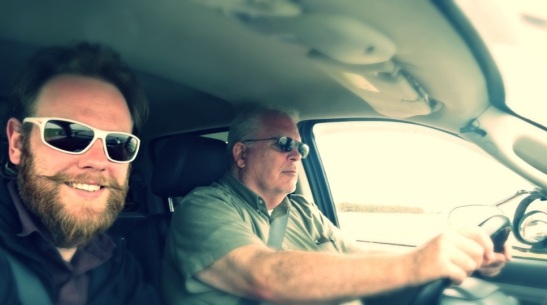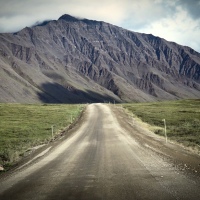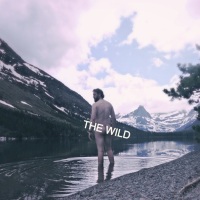McDonalds: It’s exciting because I might die?

KP gripped the steering wheel, repeated phrases to himself to keep his nerves on an even keel, and while attempting to avoid driving a tyre or two over the edge of the frozen cliff for which there was no barrier, I had my heart in my throat while I tried to admire the view. The immediate, deathly drop from the side of the passenger door was one which I both savoured and feared, especially as KP seemed so fixated on it. I calmed our nerves (I think), and embraced the fact that if I was going to die, I would at least try to have a few decent photos of it.
Very few of you will check a map if I regurgitate road numbers or mention trails, but for the industrious amongst you, taking route 89 and then the rather breathtaking 44 over the Rockies, in a long winter, in high winds, in a high sided truck, was possibly the first (but not the last) “exciting-because-I-might-die” expedition on the journey so far, at least while in a vehicle.

When the moment comes to be informed by your pilot that he has an acute fear of falling, and that moment is precisely when a shaky, colourful bus of hippies, lacking driving confidence and the ability to keep their bus moving in a straight line, starts veering down the mountain towards you on a damp road, and you’re creeping up an incline which has no barrier, with a hard shoulder which quickly disintegrates towards a fatal fall, it becomes apparent that tripping over Montana’s snowy peaks is not going to be an walk in the park. The hippies also signalled to us that it was a relief that they had made it over the pass alive – not exactly a instant confidence boost for my fearful captain!

The view was spectacular, I managed to grapple with my camera, and obviously after a test of stirling character, KP held his nerve: we didn’t die.
On entering National Parks, I have learnt that there are only two types of staff member who you are greeted by. The first is the more common of the two; the unnaturally personal, over-friendly, knowledgable, eager to make your day the happiest you’ve ever experienced in your life with a forced, trained smile, typically “American” customer service rep with a “have a nice day” catchphrase. They are assuming the position of a ranger-in-training, ending each sentence with “Sir” and excessively displaying their baking soda-brushed teeth in order to blind you with kindness.
There doesn’t appear to any middle ground, but the second type is a part timer, simply sat without any knowledge whatsoever of the park or attraction you’re about to encounter, and who’s sole purpose is to take your money and seemingly, as rapidly as possible, “welcome” the next vehicle to the window.

At the east and west entrances of Glacier National Park, I met both. As a Englishman, the first welcomer makes my skin crawl and my inner monologue plays out a scene of wrapping, and turning their immaculate false manners into a well-folded, stern note of displeasing colourful language, before sliding it slowly through their letter box (oh how very British of me), that, or a fist into their probably over polite oesophagus.
The second welcome is real, from someone who genuinely has an unsavoury taste in their mouth over the position they are in. They are unhelpful, but at least it’s an authentic conversation. I’m yet decided on who I dislike meeting more at the gates.
The McDonald Lodge on Lake McDonald has nothing to do with McDonald’s. There wasn’t a popular “Scottish” restaurant in sight, nor was there much indication of other large commercial amenities throughout the park.

Apart from the infamous red buses still running up and down the Road to the Sun for the pleasure of the park’s guests and staff, I heard that some commercial draws had been dismantled, to return the touristic blemishes on the landscape back to how nature intended. It may be a monumental, 21st century step in a forward direction, but that’s not to say that reduced amenities or accommodation is lessening the purse load for the new company that just acquired the concessions contract in Glacier: estimated to turn over $18.5 million this year. Overheads aren’t to be ignored however, and neither are logistical issues in the wilderness. Waste for example, is helicoptered out of the more remote chalet areas each autumn; not your usual or most cost effective service.

Even though tourism in the park is huge business, 60% of the parks concessions and money spinners are outside the park itself – a partial testament to some positive thinking which goes on in these federal-run tourism outlets.
The national parks and everything in them are owned by the government, and run by the state. They dictate the legislation around everything that goes on in the parks, and this doesn’t sit too comfortably with me. Laws have put ownership on creatures. In fact, state laws outline that any wild animal within their borders belong to that state. Having a law which protects or allows hunting of animals is one thing, but declaring ownership is fundamentally wrong (I am aware that we have the same law when it comes to the swans of Her Royal Highness), but it’s a wild animal. I’m not sure how else to phrase that so that it outlines my argument more clearly. It is a WILD animal. I suppose its no different from a country “owning” it’s natives and giving them all social security numbers in order to be street-legal… Land of the free!

However I choose to look at the set up of the national parks, and however I look to compare them to the British national trust-run sites, I struggle to see a majority in benefits of having federally-owned, natural places of interest. I could elaborate, but something’s can be saved for a much longer read.

After waking up at Sprague camp ground in western Glacier, the long road back to my original route began. Although lacking the grandiose of Glacier National Park, there were other reasons why I had, for twenty years, romantically dreamt of delving deeper into my next neighbourhood of Montana.



